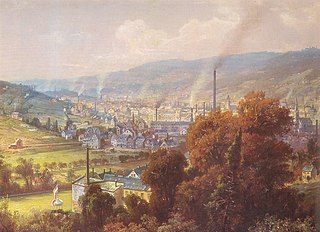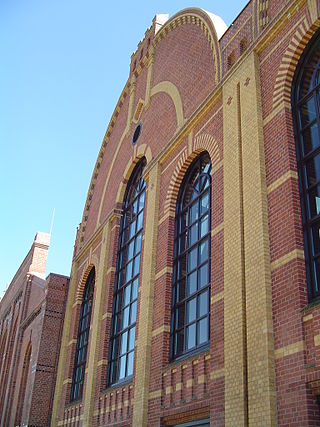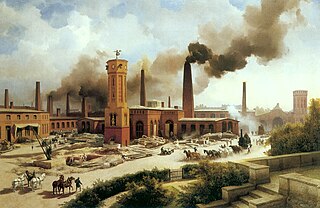
Derwent Valley Mills is a World Heritage Site along the River Derwent in Derbyshire, England, designated in December 2001. It is administered by the Derwent Valley Mills Partnership. The modern factory, or 'mill', system was born here in the 18th century to accommodate the new technology for spinning cotton developed by Richard Arkwright. With advancements in technology, it became possible to produce cotton continuously. The system was adopted throughout the valley, and later spread so that by 1788 there were over 200 Arkwright-type mills in Britain. Arkwright's inventions and system of organising labour was exported to Europe and the United States.

The Bergisches Land is a low mountain range in the state of North Rhine-Westphalia, Germany, east of the Rhine and south of the Ruhr. The landscape is shaped by forests, meadows, rivers and creeks and contains over twenty artificial lakes. Wuppertal is the biggest town, while the southern part has economic and socio-cultural ties to Cologne. Wuppertal and the neighbouring cities of Remscheid and Solingen form the Bergisches Städtedreieck.

Sir Richard Arkwright was an English inventor and a leading entrepreneur during the early Industrial Revolution. He is credited as the driving force behind the development of the spinning frame, known as the water frame after it was adapted to use water power; and he patented a rotary carding engine to convert raw cotton to 'cotton lap' prior to spinning. He was the first to develop factories housing both mechanised carding and spinning operations.

Cromford is a village and civil parish in Derbyshire, England, in the valley of the River Derwent between Wirksworth and Matlock. It is 17 miles (27 km) north of Derby, 2 miles (3.2 km) south of Matlock and 1 mile (1.6 km) south of Matlock Bath. It is first mentioned in the 11th-century Domesday Book as Crumforde, a berewick of Wirksworth, and this remained the case throughout the Middle Ages. The population at the 2011 Census was 1,433. It is principally known for its historical connection with Richard Arkwright and the nearby Cromford Mill, which he built outside the village in 1771. Cromford is in the Derwent Valley Mills World Heritage Site.

The water frame is a spinning frame that is powered by a water-wheel.

Textile manufacture during the British Industrial Revolution was centred in south Lancashire and the towns on both sides of the Pennines in the United Kingdom. The main drivers of the Industrial Revolution were textile manufacturing, iron founding, steam power, oil drilling, the discovery of electricity and its many industrial applications, the telegraph and many others. Railroads, steamboats, the telegraph and other innovations massively increased worker productivity and raised standards of living by greatly reducing time spent during travel, transportation and communications.

Ratingen is a town in the district of Mettmann in North Rhine-Westphalia, Germany. It lies in the northwestern part of Berg about 12 km northeast of Düsseldorf.

Engelskirchen is a municipality in Oberbergischer Kreis, Germany in North Rhine-Westphalia, about 40 kilometres east of Cologne. The neighbouring municipalities are Overath, Lindlar, Gummersbach, Wiehl and Much.

Richard Arkwright junior, the son of Sir Richard Arkwright of Cromford, Derbyshire, was a mills owner, turned banker, investor and financier (creditor) of many successful state and private entreprises of the British Industrial Revolution which his father had helped to catalyse. Among his debtors were Samuel Oldknow of Marple and Mellor, his friend. He was one of ten known British millionaires in 1799.

Cromford Mill is the world's first water-powered cotton spinning mill, developed by Richard Arkwright in 1771 in Cromford, Derbyshire, England. The mill structure is classified as a Grade I listed building. It is now the centrepiece of the Derwent Valley Mills UNESCO World Heritage Site, and is a multi-use visitor centre with shops, galleries, restaurants and cafes.

The Mueller Cloth Mill, located in Euskirchen, North Rhine-Westphalia, Germany is a section of the LVR Museum of Industry. The museum provides insight into the production process of a cloth mill by showing fully working machinery and equipment from around 1900. Opened in 2000, the museum preserves the mill's state at its shutdown in 1961. LVR Industrial Museum Mueller Cloth Mill is an ‘Anchor Point’ of the European Route of Industrial Heritage and a central stop on the ‘Wool Route’.

The Saxon Museum of Industry is a museum with four locations in Saxony. It is organised as a "special purpose association", the members of which are the towns of Chemnitz, Crimmitschau, Ehrenfriedersdorf and Hoyerswerda.

The Textilfabrik Cromford in Ratingen, North Rhine-Westphalia, Germany was built in 1783 by Johann Gottfried Brügelmann. It was the first cotton spinning mill on the European mainland. Today it is an industrial museum specialising in textile history.

The Baumwollspinnerei Ermen & Engels is a former cotton mill in Engelskirchen, Nordrhein-Westfalen, Germany. It is now part of the LVR Industrial Museum.

The Augsburg textile and industry museum, known by its acronym tim, is a museum in Augsburg a city in the south-west of Bavaria, Germany. It is situated in the Augsburger Kammgarnspinnerei, a former worsted spinning mill. The museum is an Anchor point on the European Route of Industrial Heritage.

The Bocholt textile museum is a museum in Bocholt, a city in the north-west of North Rhine-Westphalia, Germany, part of the district Borken. It is situated 4 km south of the border with the Netherlands. The museum opened in 1989 as one of the eight locations of the LWL Industrial Museum: it is an Anchor point on the European Route of Industrial Heritage.

The Museum of Industry, Work and Textiles is a museum in Ghent in Belgium. Ghent was at the centre of the Flanders textile region. The museum is an Anchor point on the European Route of Industrial Heritage.

Industrialization in Germany was the phase of the breakthrough of industrialization in Germany, beginning at the time from around 1815 to 1835. This period was preceded by the periods of pre-industrialization and early industrialization. In general, the decades between the 1830s and 1873 are considered the phase of industrial take off. The Industrial Revolution was followed by the phase of high industrialization during the German Empire. The (catch-up) Industrial Revolution in Germany differed from that of the pioneering country of Great Britain in that the key industries became not the textile industry but coal production, steel production and railroad construction.

UCO Galveston was a cotton spinning mill in Ghent, located at Wiedauwkaai 52. It was also known as NV Galveston or Cotonnière Galveston.


















